It’s always interesting when a game tries to clone another game. This isn’t a new thing in the gaming industry, it’s been going on since the Atari 2600 and the Intellivision, probably earlier than that. Usually the result is a blatantly inferior derivative work. Sometimes they’ll do a slightly different take on a successful formula, and it’ll actually come out pretty cool. That’s what happened when NAMCO made Burning Force.
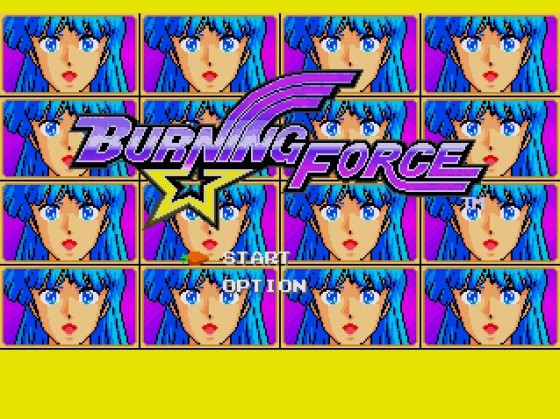
The title screen! Why is the cursor a carrot? Japan.
Burning Force was originally released in arcades in 1989, several years after Space Harrier, and was ported to the Genesis/MegaDrive and Sharp X68000. I mainly want to look at the Genesis/MD version since that was the one released in the most territories and the one most people played. When it came out, it caught my eye because it was the first Genesis game I saw that came in a different color box. Most games on the system came in the now iconic black game cases. Burning Force was in a rebellious bright orange box, paired alongside Pheilos in its brilliant bright blue. There were like gems. I had to have them.
The storyline does a bit of a different take than most shooters of this style. You’re not saving the world. There’s no evil to subdue. You’re Hiromi Tengenji and you’re simply taking a test to become a “Space Fighter.” You need to go through six days worth of trials on your hover scooter to pass and…get your hat. This is all so you can go on space adventures, or something. You’d think the story would take place AFTER the test and be about the space adventures, but no. This is like the SAT of shooters, or something like that.
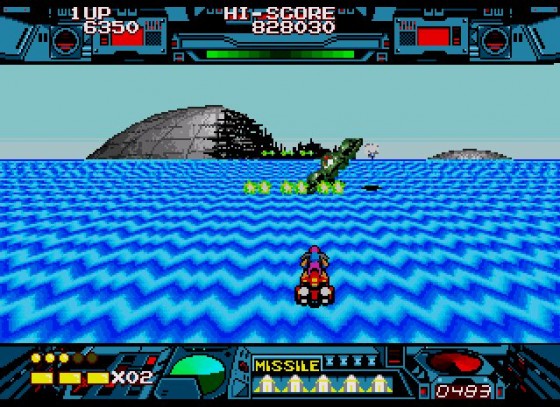
Nothing says bad-ass like shooting down a spaceship on a scooter.
The gameplay is mostly the same fare from Space Harrier and some of the other “Super Scaler” games. Enemies move towards you or approach from behind to attack and you have to move around the screen to avoid or shoot them. To spice things up, throughout the game you’re given different types of weapons and missiles to use. I pretty much found myself sticking to the wide shot and the homing missiles, but the laser was pretty useful too. You have a limited number of missiles, so it’s important to collect them when you can. You can also speed up or slow down to help collect some of the other weapons or the bouncing green balls. I’m not really certain what the green balls do, so bonus points to the reader who can tell me. As far as I can tell their only purpose is to drive me crazy figuring out what they’re for. There’s a timer as well, but there isn’t much of a penalty for running it down aside from not getting bonus points.
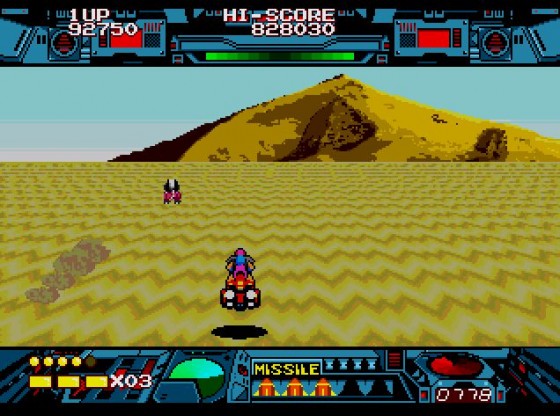
Ugh! I don’t want to think about the road rash you’d get from falling off in this place!
There are five main “days”, divided into four areas. During the first two areas you’re restricted to left and right movements. There are jump pads you can ride over so you can maneuver around and collect power ups or shoot harder to reach enemies. At the end of the first two areas you’ll fight a mini boss that isn’t too difficult. The third area will greet you with a giant ship where your team will upgrade your scooter to a flying ship and you’ll be shown where to attack the boss. Now you’re allowed to move in all directions, and the enemies and the build of the levels will also accommodate for this. Once you defeat the boss, you’ll move onto a fourth bonus area where you collect points and a chance for a 1up. There is an additional sixth, final day, which only has one area to it and is mostly reserved for the final boss fight.
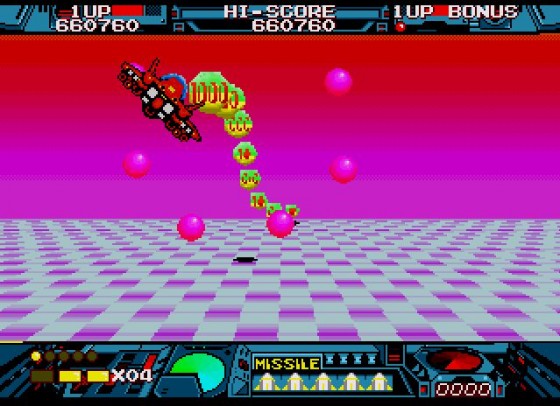
Do a barrel roll! Oh whoops, wrong game.
The music is hit or miss. The first two days remind me a lot of Nintendo’s F-Zero, as it sets the mood right and gets you into the game. Everything after that isn’t bad, but it didn’t really sink in for me. The third day’s music was interesting, but the pacing didn’t fit the game much. Most of the music doesn’t give you that sense of speed or urgency you’d expect. The sound effects aren’t much to write home about either, nothing jumps out as amazing but nothing outright annoyed me either.
Burning Force has decent scaling for an early Genesis game. NAMCO actually does a better job with it than SEGA’s own Space Harrier II, and it’s very impressive. The sprite scaling is incredibly smooth considering the lack of Mode 7 capabilities on the Genesis. The color palette is decent too, actually showing off a bright variety of colors which is also a nice feat on the system as well. A lot of the early Genesis games had a dull, gritty look to them. This is the first game I remember seeing on it that was bright, colorful, and cartoony. The enemies and the bosses have a good variety, the robot designs are really cool looking, and a lot of the enemies range from imaginative to outright weird. Some of the mini bosses seem lifted from Space Harrier, but that’s forgivable when you’re blowing up chess pieces and fighting a giant zipper.
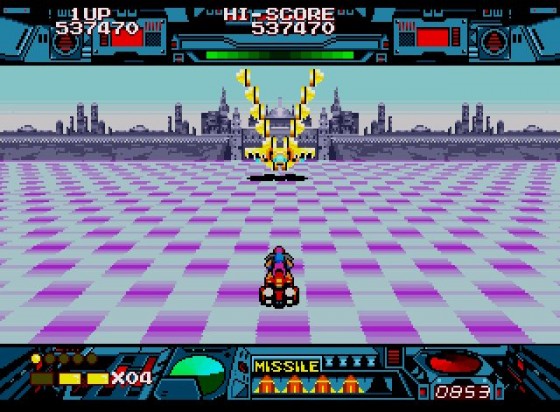
How is this going to attack me? Am I going to get stuck in it?
All in all, Burning Force is a decent game. It’s not amazing or groundbreaking but it’s at least a fun way to kill half an hour or so. If you’re a hardcore Genesis/MD fan, or just really love Space Harrier you’re definitely going to want to check it out. There’s a Virtual Console release, which is a port of arcade version, but it’s only available in Japan. However, the original cartridge isn’t hard to come by. As far as the other version go, I briefly played the arcade version and it was basically the same as the Genesis/MD version but with better graphics and sound. There didn’t seem to be anything different, but the gameplay seemed a bit smoother. I’d assume the X68000 version to be mostly identical to the arcade version. While there was never a sequel, Hiromi Tengenji was not forgotten by the folks at Namco as she appeared many years later in Namco X Capcom.

The redundant department of redundancy is on lines 1 and 2.
Play it? Beat it? Know what the green bouncing balls are for and want to berate me for not knowing? Leave a comment below or drop by my Facebook or Twitter!


